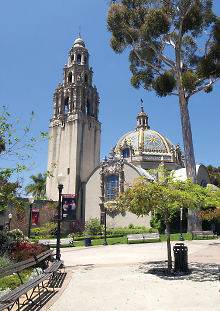San Diego’s Balboa Park is more than a big open space with trees.
True, trees abound—350 species in all—but the 1,200-acre park is also home to 19 gardens running the gamut from cactus to roses. There is a Japanese garden, a California native plant garden, and a children’s ethnobotany garden, among others.
But there’s more. The park—said to be America’s largest urban cultural park—also contains 17 museums and nine performing-arts spaces, plus tennis courts, hiking trails, a carousel, a golf course, a soccer field, a lawn-bowling green, and the city’s renowned zoo. The park is just a 10-minute drive or cab ride from the San Diego Convention Center.
Park rangers lead historical tours of Balboa Park at 11 a.m., every Tuesday and Saturday. Most of the cultural institutions in Balboa Park also offer tours of their collections, beginning at 11 a.m. on Saturdays.
APA members may be interested to learn that on the third Saturday of every month (which includes May 20), the Fleet Science Center opens its doors early for adults and families with children with autism. From 9 a.m. to 10 a.m., one hour before regular open hours for the public, visitors are welcome to enjoy the Fleet’s galleries in a quieter setting. The center presents a special IMAX film screening at 10 a.m., with the soundtrack volume reduced and house lights on.
Also during APA’s Annual Meeting, the Old Globe, a leading regional theater located in Balboa Park, will present the West Coast premiere of “The Old Man and The Old Moon,” a fable about lost love and the lost light of the moon.
Balboa Park was first laid out in 1868 on 1,400 acres of open land but lay largely fallow for more than two decades. The San Diego Natural History Museum, the oldest scientific institution in Southern California, opened there in 1874. But a program to plant trees got going only in 1892, followed by road- and water- system construction from 1903 to 1910.
The park’s first building boom came with the 1915-1916 Panama-California Exposition, commemorating the opening of the Panama Canal, when dozens of structures were built. Three more major museums were built in the 1920s and 1930s. Then, the 1935-1936 California Pacific International Exposition saw still more development of theaters, museums, gardens, and music venues.
The city’s visual icon, the California Tower, was designed in the style of a Spanish-Colonial church and today is part of the Museum of Man.
Most of the buildings in the central part of the park were taken over during World War II by the U.S. Navy as extensions of Balboa Naval Hospital. Four hundred beds were installed in the Museum of Art, while the House of Hospitality became a nurses’ dormitory, and the Lily Pond in front of the Botanical Building became a rehabilitation pool.
Still more museums were built or installed in old buildings during the five decades after the war.
Today, the San Diego Museum of Art has a strong collection of Spanish Baroque and Renaissance paintings, including works by El Greco, Goya, Rubens, and van Ruisdael, as well as important examples of South Asian art and Indian miniatures.
The Mingei International Museum presents wide-ranging groupings of folk art from around the world, including ceramics, jewelry, textiles, toys, and furniture.
Outdoors, the park features simple open spaces, walking paths, and zones of vegetation native to southern California. To cite just some of the many gardens, two focus on particular plants and insects.
Palm Canyon is a tropical oasis, reached by following winding paths through a shady, lush canyon containing more than 450 palms representing 58 species. The original group of Mexican fan palms—the canyon’s most prominent feature—dates to 1912. In 2001, the California Conservation Corps restored the historic trail that connected Palm Canyon to the Old Cactus Garden.
The Zoro Garden has its own spicy history, originating as a nudist colony during the 1935 California-Pacific Exposition. Today, its sunken stone grotto forms the center of a butterfly garden, containing the larvae and nectar plants needed for the complete life cycle of butterflies. Miniature indentations built into rocks collect small pools of water for the monarch, sulfur, and swallowtail butterflies that flit among the colorful perennials and the ficus trees surrounding the garden.
Visitors to Balboa Park can walk around the 65 miles of trails for free, but many museums and other venues charge admission. And for real lawn bowling fans, play starts each Tuesday and Saturday at 9:30 a.m.; Wednesday, Friday, Sunday at 1 p.m.; and Thursday at 10 a.m. Spectators can watch for free. ■
More Information on Balboa Park can be accessed
here.


